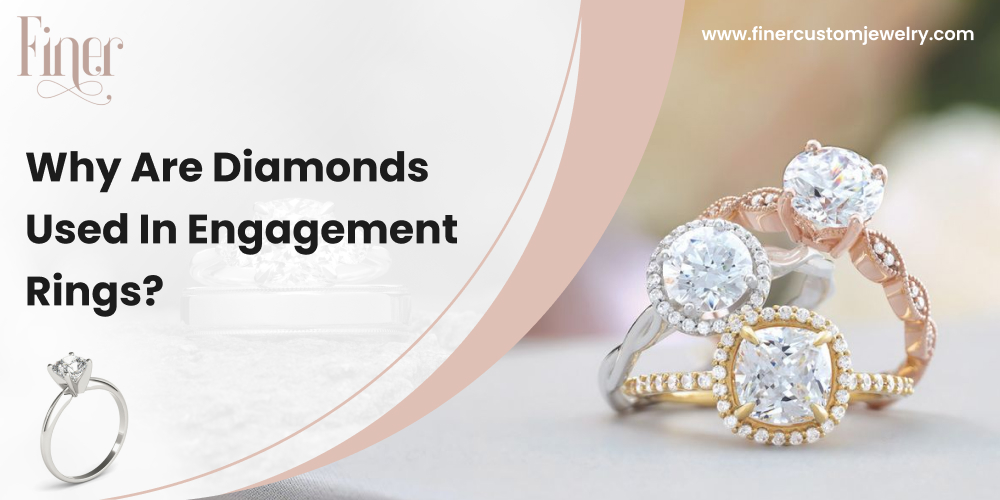
Engagement rings are popular in our culture, and they’re a significant one at that! After all, every lady fantasizes about the day when the guy of her dreams presents her with a sparkling ring. However, how often do we consider where this custom originated and how it evolved into the celebrity-studded extravaganza today?
This is an intriguing topic to investigate, so we’ve included some background information about diamond engagement rings below. How did a phrase like “a diamond is forever” come, and how did these gleaming stones earn today’s status in the wedding industry? Continue reading to learn more.
The precise origins of the engagement ring tradition in connection to diamonds are unknown. On the other hand, historians have specific theories on the subject that they prefer to reference. According to anthropologists, this practice began as a Roman custom in which women wore rings linked to tiny keys. These were supposed to show that their spouses owned them.
According to historical sources, Archduke Maximilian of Austria is thought to have commissioned the first diamond engagement ring in 1477. This was for Mary of Burgundy, his fiancée. As far as historians can determine, this started the practice of European royalty and nobility purchasing diamond rings in large quantities.
Diamond rings were increasingly popular among men to symbolize their love and devotion to those they cared about.
Victorians are said to have popularized elaborate engagement ring styles from there. Diamonds were frequently combined with other jewels and a variety of precious metals and enamels.
These rings were known as “posey rings” because they were made in the shape of flowers. The habit of combining diamonds with other gems and usually placing them in filigree settings lasted until the Edwardian era.
Let’s fast forward to 1948, when a famous catchphrase was born. De Beers was the brand that created the phrase “A Diamond is Forever.” This campaign was a huge success, resulting in many purchases. This statement was not only catchy and attractive, but it also had additional meanings that led to the rise in the popularity of diamonds.
The image of a diamond being “forever” conveyed that diamonds are incredibly durable. A diamond forever reflects the forever commitment of a wedding. Advertising Age dubbed this phrase the “slogan of the century” in 1999.
When the sales of diamonds declined due to the economic crisis, the company that worked to make diamonds made this campaign and got a huge success.
Thanks to De Beers’ commercial push, the custom of diamond engagement rings was born and flourished in society. Even if the “engagement diamond tradition” had not yet caught fire, De Beers annual reports from the 1940s frequently mentioned it. On the other hand, the public began to carry on the tradition as more advertising focused on it. In 1951, a diamond engagement ring was given to eight out of ten American women. Since then, the figure has stayed mostly unchanged.
This trend continues today, with many couples seeking Scottsdale custom-designed engagement rings to symbolize their commitment. The enduring appeal of diamonds has evolved to include more personalized options, allowing couples to create a finer custom made engagement ring that reflects their unique love story while maintaining the timeless allure of diamonds.
In the past, engagement rings were far less romantic than they are now. They were once considered a sign of ownership. To indicate that they belonged to their spouses, women were given gold rings by their husbands and metal rings to wear at home. This custom has grown over time and is now associated with love and devotion.
Diamonds were the first gemstones used in engagement rings, and when they were discovered in abundance in South Africa, the diamond industry advertised them as “The” engagement stone. The Great Depression slowed things down for a while, but as the economy recovered, things started up again.
Diamond engagement rings are now seen in almost every culture. Individuals are moving away from old customs and adopting a new realm of individuality as time passes.
Engagement rings used to symbolize ownership, but they now symbolize partnership and commitment. It’s only natural that tradition develops in a culture that values all types of love. The typical white diamond engagement ring can be replaced with a fancy color diamond engagement ring. With so many colors, shapes, and sizes to choose from, it’s no surprise that more and more couples are expressing their love via fancy colored diamond engagement rings.
Do you have a vision for your custom engagement ring, but aren’t sure how to make it a reality? Allow us to guide you through the process of how to create truly exceptional rings. Schedule your design appointment today and see how Finer Custom Engagement Rings and Diamonds will bring your vision of an engagement ring to life.
© Copyright Finer Custom Jewelry 2024